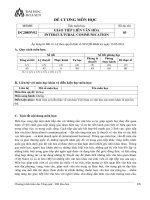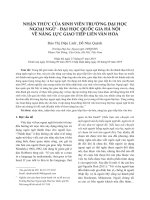Giao tiếp liên văn hóa final assignment 1
Bạn đang xem bản rút gọn của tài liệu. Xem và tải ngay bản đầy đủ của tài liệu tại đây (101.83 KB, 5 trang )
Question: Conflicts between Vietnam-based international education institutions and
Vietnamese parents have been increasingly reported on social media. What are your opinions
about the reasons for such incidents and the ways the involved solve the problem? What
would you do otherwise? Elaborate your points by investigating one or more cases from an
intercultural perspective.
Final Assignment
When it comes to parents, teachers, and administrators of educational institutions,
disagreements and confrontations are unavoidable. Nowadays, conflicts between Vietnam-based
international education institutions and Vietnamese parents have been reported increasingly on
social media. The conflict was defined for the purposes of the study as real or perceived
differences that arise from specific educational circumstances and elicit negative emotion as a
result (Deutsch, 1873). It has always been like that, the frequency of conflicts being reported a
lot is not due to an increase in the number of conflicts, but because of the growth of social
networks and the popularity of live streaming, all problems are now being discussed online.
Along with that, the nature of these contradictions is still present, however, in the past, people in
general and parents, in particular, did not use social networks as much as now, so little
information was put on social networks.
The essay will first look at four categories of factors that have a bearing on how parentschool conflict intensifies or cools down: Discrepant views of a child or a child’s needs,
knowledge, constraints, communication, and trust.
According to a study by Jeannie Lake, ninety percent of responders said that different
perspectives on a child can lead to or intensify conflict. Parents believed that two reasons led to
the different perspectives: either the school did not see their child as an individual with special
talents and abilities or it perceived the child from a deficit-model perspective, concentrating
primarily on the child's deficits. Parents reportedly became “single-minded” about what was best
for their children, which led them to reject suggestions for good programming, according to
school authorities. According to one mediator, students may demonstrate a skill outside of class
but not inside of it, and since parents may only notice the former and school personnel may only
notice the latter, each side gets distinct and incomplete conclusions.
When it comes to knowledge, parents, teachers, and mediators have all identified two
things as conflict-escalating factors: a lack of problem-solving knowledge and communication
techniques. One school official recommended that special education managers and school staff
should quickly disclose that information to parents to prevent them from seeking it from outside
organizations. Parents complain about the fact that it is extremely difficult for them to advocate
on behalf of their children due to an “imbalance” of knowledge, where parents lack the
knowledge that school officials already have. All three groups agreed that parents are unsure if
their knowledge is adequate to form wise opinions regarding the assessments and services their
children are receiving. Too frequently, parents learn about their lack of knowledge when the first
argument about their kids' education occurs.
The restrictions are still another crucial point. Resource limitations, including those
related to time, money, people, and resources, have an impact on conflicts. In Particular,
finances made conflicts worse. They tend to create “turf battles”, where parents of children feel
too much money is going to serve the institutions but they do not see the equivalent result.
Suspicions could arise about money being the unstated, hidden reason to deny services.
Concerning the final factor involving communication and trust, conflicts tended to
increase when communication was inadequate, misunderstood, inaccurate, dishonest, or
avoided. If people felt that they were not being heard or listened to, the same thing applied.
When schools brought too many officials to team meetings, parents felt intimidated to
communicate. On the other hand, mediation with a neutral third party was praised by both
parents and school administrators for enabling them to feel safe and comfortable, open up, and
have real conversations about their needs and feelings, frequently for the first time. It was much
simpler for parents to put up with minor glitches or mistakes if they trusted the school staff.
Parents lost faith in the procedure when that trust was broken or lacking, and school
administrators disregarded their suggestions. In some instances, school officials were unaware
of the moment a parent decided to give up or trust in the institution's ability to put things right
for the student. Over time, parents who didn't have belief in the school stopped wishing for
positive outcomes or mutual communication and instead began requesting out-of-district
placements, school changes, mediation, or due process hearings.
We explored the causes of the conflict between institutions and parents; now it's time to
consider solutions to this challenging issue. To start, we must determine the causes of the issues.
Because if we do not comprehend the struggle, it is tough. School administrators can close gaps
between parent and school viewpoints if they can identify what parents need and separate those
needs from the parents' positions. When teachers take the parents' long- and short-term goals for
their students, the same thing occurs. Instead of just concentrating on the students' deficiencies,
educators must take into account all of the student's skills, including their talents, desires, needs,
and objectives. Financial limitations are still another crucial component. The ability of parents to
decide critically about a student's educational plans may be affected as a result. Additionally,
parents must educate themselves on the new services and programs offered by the school where
they intend to enroll their children. If parents are unable to determine if certain service offerings
are appropriate due to a lack of information, they cannot speak out for their children. When
educators build solid, mutually beneficial relationships with parents and students, power battles
between schools and parents can be avoided. These interactions require effective negotiation,
problem-solving, and communication abilities. Building and maintaining trust is a joint
responsibility of parents and educators. When disagreements arise, it is up to both parties to
adopt collaborative and conciliatory stances.
In detail, the case of school violence among students at International School Ho Chi
Minh City - American Academy (ISHCMC-AA) has not shown signs of cooling down in the
media recently. Initially, the friction arose from a conflict between students, but because the
school did not actively contact to resolve the issue with parents, leading to an escalation that had
a great impact on the school. The cause of the escalation of conflicts here starts from
unnecessary reasons: The school, instead of calling parents to listen to the problem, chooses to
send an email, and only respond within the working day. main; This causes frustration for
parents who also spend money to use the service. After that, when parents came to the place to
solve it, the school was not skillful in communicating and negotiating with parents, causing the
frustration to rise. Instead of apologizing to appease the parents and proceed to find a solution
together, the school used the resolution culture of foreigners in Vietnam, which is refusing to
negotiate and calling the police. This is the reason why things get out of control. From this
example, we can see a common situation in international schools when there is a conflict with
Vietnamese parents, that's why the root of the problem is usually very small, but due to not
understanding the behavior culture as well as the mind. The behavior of new service users leads
to inappropriate actions, causing an escalation in conflicts and serious consequences. The matter
did not stop there, after receiving an unsatisfactory solution from the school, Ms. Thuy - the
parent of a student who suffered from school violence has live streamed online, and attracted
more than 200,000 viewers each Livestream. Instead of finding a way to apologize and
reconcile, bringing the tension down, the school continues to choose to remain silent. This
inadvertently made the public angrier and no longer cared about right and wrong, leading to a
serious impact on the brand's brand as well as the evaluation of the school's quality.
If I put myself in the role of an international school with a conflict with parents, I would
suggest a solution based on the perspective of Vietnamese people, who understand the
Vietnamese culture and service market as follows: when there is a conflict with parents, the first
thing to do is to actively find ways to connect with all the people that relevant to the problem,
especially parents, so that they can see a professional and caring attitude towards students. After
the connection is established, the school side will listen to the issues with the following criteria:
Understanding, and goodwill to cooperate. After listening to the problems and having
conversations with parents, the school will make an appointment to meet face-to-face to discuss
how to solve the problem and at the same time coordinate to agree on a suitable solution within
the capacity of the school. With this solution, it will avoid raising tensions, and at the same time,
show goodwill and respect for all the people. Along with that, the school needs to show a
professional attitude, be ready to apologize if necessary, and not shy away, to limit
unprofessional images from being recorded and released on social networking platforms,
causing waves of negative public opinion towards the school. In addition, if I am a parent, I will
go to the school to discuss to understand the situation and find a solution to minimize the bad
outcomes as much as possible.
When it comes to resolving conflicts and school issues, that says, the decisive role of the
state, the government, and the participation of social organizations have only a supporting role.
School contradictions and conflicts have root causes and can only be completely resolved when
the root problem is dealt with. This requires approaches, methods, and tools to deal with specific
types of conflicts. Building and maintaining trust is a joint responsibility of parents and
educators. When disagreements arise, it is up to both parties to maintain collaborative and
conciliatory attitudes. If both parties see conflict as a chance for improvement, change, novel
creative problem-solving, enhanced self-evaluation, and skill testing, then it is not always a bad
thing.
REFERENCES
1. Bennett, D. S. (1996). Security, bargaining, and the end of interstate rivalry.
International
Studies
Quarterly,
40(2),
157-183.
Retrieved
from
/>fbclid=IwAR1nxCI7ANmOpaSeTR4sqP7AdSSNBfqZHD0FVzgHaTeN3VI8mQq_FEIyn0
2. Besnier, N. (1995). Literacy, emotion and authority: reading and writing on a
Polynesian atoll (No. 16). Cambridge University Press.
3. Ryan, R. M., & Deci, E. L. (2017). Self-determination theory: Basic psychological needs
in motivation, development, and wellness. Guilford Publications.









